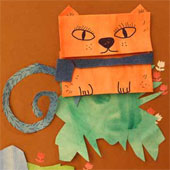• Unlike cutout 2D has more smooth animation and is perfect to show fluidity in actions and rhythmic flow like morphing, transition etc.
• Any detail applied to a cut out shape will limit the angle at which animator can take a picture of the frame.
• Cut out animation doesn’t work well for facial close-ups so dialogue that requires the lip movements of the character to be synchronized with recorded sound lip sync is rare with respect to its limitations.
• These techniques of course have limitations. They are flat and they must work across or up and down the screen in a flat plane. One can’t simply walk a cut–out puppet towards camers in relation to fixed background or make it turn in three dimensions.
• Cut out animation is typically used for mimed stories.
• The most important is the jerky moving effects it produces that brings its own limitation of a striking visual style.
• Animators have more difficulty controlling movement with this style then in 2D animation, in which characters and scenes are drawn or painted on transparent celluloid sheets, so they need to plan the action accordingly.
• Cut out is also a highly personal experience, the animator essentially portrays character’s mood or idea just by moving cut out shapes around over a flat plane.



